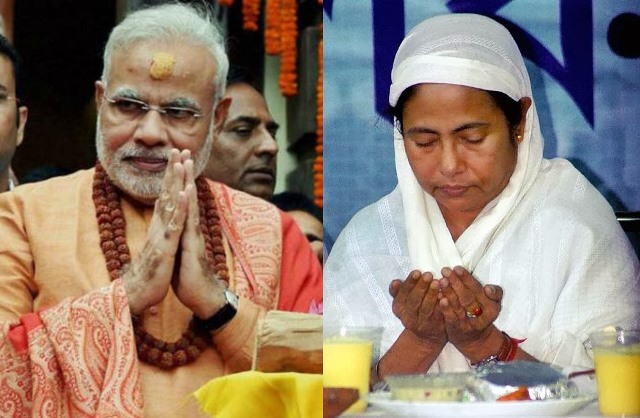Hindutva is no longer the rabble rouser vote bank as it was in the last national election. When the Arvind Kejriwal-led Aam Aadmi Party won an emphatic victory in the recent Delhi assembly election, opposition leaders were quick to point that the Bharatiya Janata Party will have to recalibrate its strategy of polarisation now that it had been roundly rejected by the electorate of yet another state.
However, it would be extremely difficult for the saffron party to abandon its majoritarian agenda in the forthcoming state elections. For the BJP, hardline Hindutva, strident nationalism and communal talk is an article of faith.
Hindutva seems to have worked for BJP in the last election. It probably sees the current run of defeats as aberrations. Besides the Hindutva strategy helps divert attention from bread and butter issues at a time when the economy is tottering. An election is the occasion for the BJP to propagate its ideology.
ALSO READ: Oppn Must Sieze The Moment
In fact, the BJP’s high-decibel poll campaign in Delhi with its focus on the Shaheen Bagh protests against the Citizenship Amendment Act was meant not just to consolidate the Hindu vote in the Capital but also to send out a message across the country that this agitation is led by minorities and that the amended citizenship law actually enjoys popular support.
Among the opposition leaders, West Bengal chief minister and Trinamool Congress chief Mamata Banerjee appears most vulnerable in this regard. Determined to add West Bengal to its kitty, the BJP has opted for a brazenly communal narrative to dethrone Banerjee. Having met with remarkable success in the last Lok Sabha election when it surprised everyone by winning 18 seats and increased its vote share to 40 percent, the BJP has every reason to persist with this strategy. It remains undeterred by the fact that its attempts to focus on Article 370 and triple talaq did not cut much ice with the voters in Haryana, Jharkhand and Maharashtra.
It will not be surprising if the BJP’s polarising and divisive rhetoric gets more shrill as it begins preparations for next year’s assembly election in a state which has a 27 percent Muslim population.
The very fact that the BJP has re-elected Dilip Ghosh as president of the party’s West Bengal unit, is a clear message that the saffron party has no intention of going back on its communal agenda. Known for using vitriolic language, Ghosh is constantly stoking controversies with his inciting statements. Ghosh was in the eye of a storm recently when he described the anti-CAA protesters as “illiterate and uneducated” who are being fed biryani and “paid with foreign funds” to continue with their agitation. He constantly refers to the issue of infiltration in his speeches and has, on several occasions, thundered that all Bangladeshi Muslims in the state will be identified and chased out of India!
ALSO READ: ‘NRC Will Be A Disaster In Bengal‘
Not only has the BJP campaign reopened the old wounds inflicted in the communal riots during the state’s partition of 1905, it has also been helped by the fact that Mamata Banerjee is seen to be appeasing the minorities. The Trinamool Congress chief who is personally leading the prolonged protests against the amended citizenship law as well as the National Register of Citizens and the National Population Register, has given the BJP enough fodder to push ahead with its communal agenda.
Undoubtedly the Delhi defeat came as a rude shock for the BJP but, at the same time, its leaders believe the party increased its tally from three to eight seats and improved its vote share from 32 to 38 percent because it made the anti-CAA protests as the centre piece of its campaign.
It’s still too early to say if the BJP’s strategy will succeed but, at present, Mamata Banerjee has the first mover advantage over her political rival. While the saffron party lacks a strong party organisation in West Bengal and has no credible chief ministerial candidate, the Trinamool Congress chief is already in election mode.
ALSO READ: West Bengal Follows AAP Model
Like Kejriwal, she has stopped taking personal potshots at Prime Minister Narendra Modi and is instead emphasising her governance record. She has also taken the lead in articulating the dangers of the amended citizenship law, the NPR and NRC. Mamata Banerjee is taking no chances as she realizes she can ill-afford to underestimate the BJP as she had done in the 2019 Lok Sabha election.
But before it goes for broke in West Bengal, the BJP will test the waters in Bihar which is headed for polls later this year. Not only does the state have a 17 percent Muslim population, the opposition (the Rashtriya Janata Dal and the Congress) has staunchly opposed the CAA, reason enough for the saffron party to polarise the electorate on religious lines.
Besides, the BJP is banking on its alliance partner, Bihar chief minister and Janata Dal (U) president Nitish Kumar to act as a buffer against its strident campaign. Though Nitish Kumar has endorsed the CAA, he has not framed his support for the law on communal lines. Moreover, the Bihar chief minister measures his words carefully and is not known to use extreme language. This, the BJP feels, should help the alliance offset any possible adverse repercussions of the saffron party’s high-pitched tirade against those opposing the CAA.
However, if Mamata Benarjee can repeat AAP’s massive success in Bengal, voices in Bengal may start questioning Hindutva. Hindutva may be hanging by a thread.
